Osmoregulation and Thermoregulation in Organisms
1/87
There's no tags or description
Looks like no tags are added yet.
Name | Mastery | Learn | Test | Matching | Spaced |
|---|
No study sessions yet.
88 Terms
What is osmoregulation?
The process by which organisms regulate the concentrations of salts and water in their bodies.
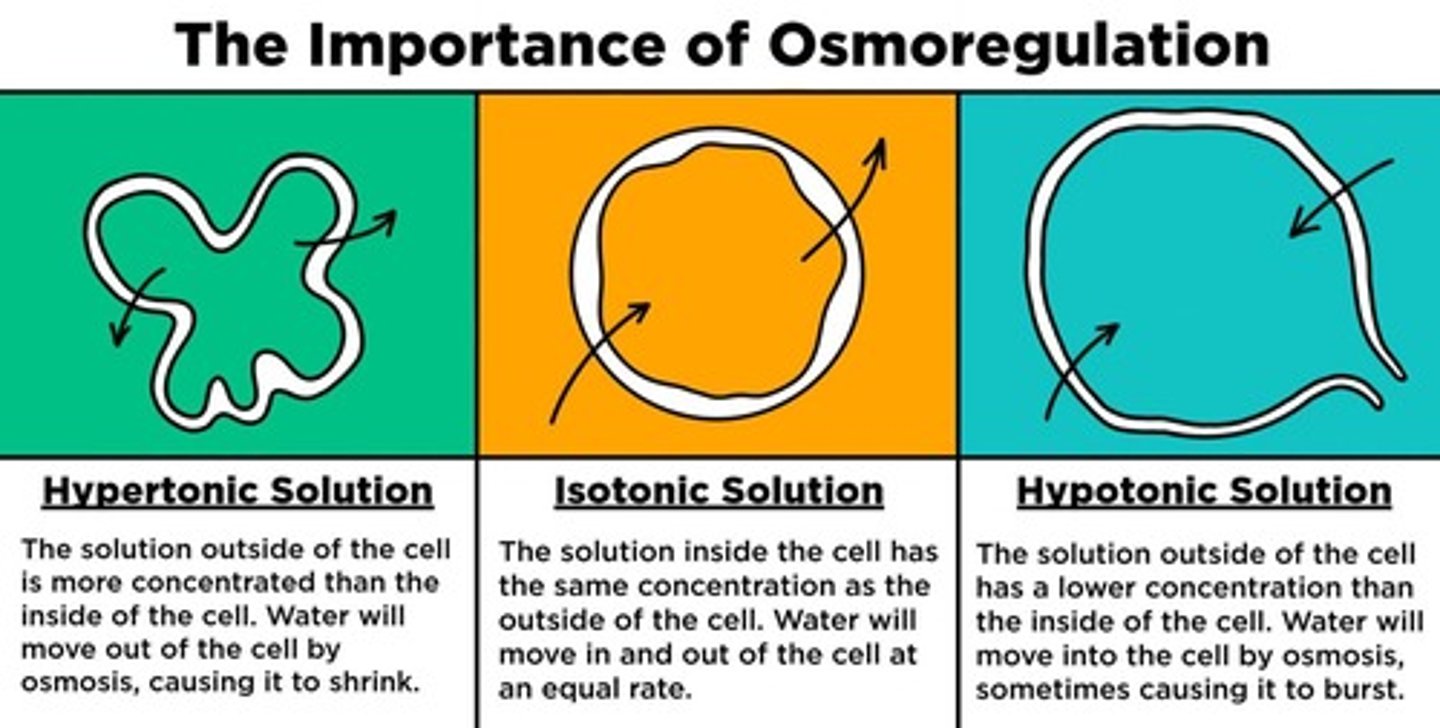
What are the three mechanisms that maintain chemical concentrations within cells?
Osmoregulation, excretion, and transport.

What is the role of osmoregulators?
Osmoregulators maintain osmolarity of body fluids independently of their environment.
What are the two types of aquatic organisms based on osmoregulation?
Osmoregulators and osmoconformers.
How do marine fish adapt to their hypotonic environment?
They drink seawater, have a low kidney filtration rate, and excrete excess salt via gills.
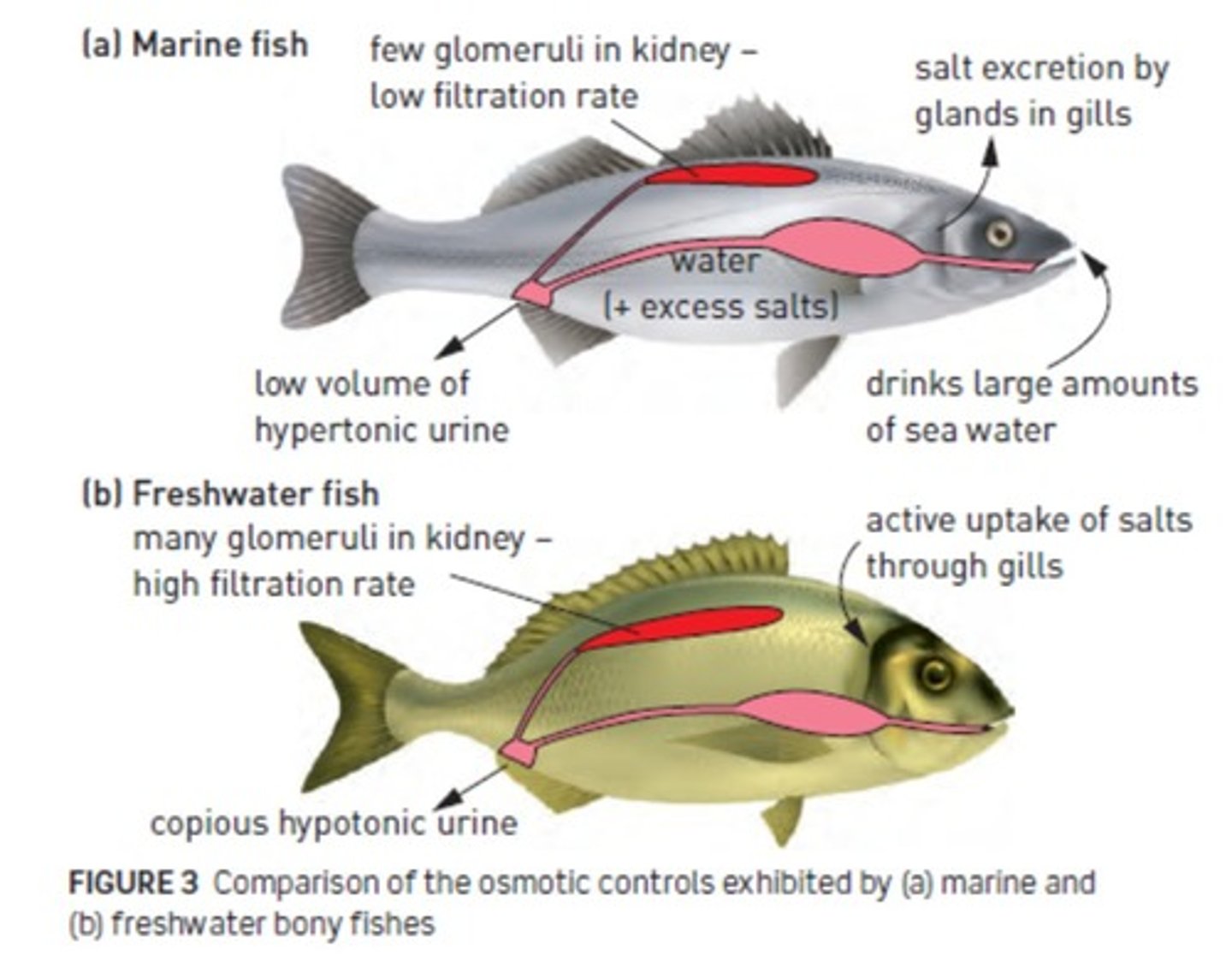
What adaptations do freshwater organisms have to prevent water gain?
They have impermeable coverings, high kidney filtration rates, and actively uptake salts.
What adaptations do terrestrial organisms have to reduce water loss?
Waterproof outer surfaces, reduced kidney filtration rate, behavioral modifications, and metabolic water usage.
What is the significance of antidiuretic hormone (ADH) in humans?
ADH regulates water balance by controlling kidney function and water reabsorption.
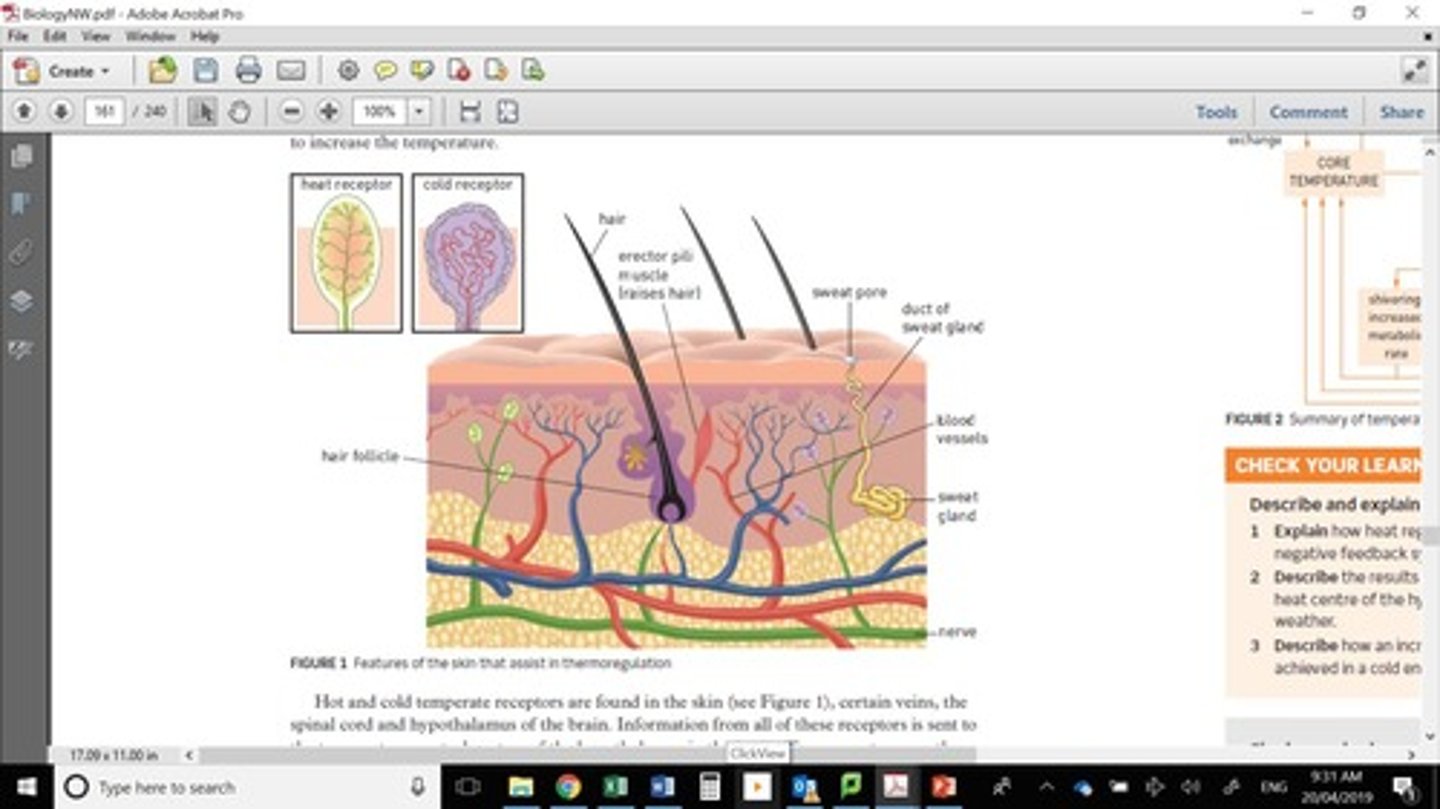
What is osmotic stress?
An abnormal concentration of dissolved solutes that disrupts homeostasis.
What are the main areas where water is found in organisms?
Transport medium, extracellular fluid, and intracellular fluid.
How do shore crabs regulate their internal salt concentration?
By actively excreting excess ions.
What is the impact of dehydration on marine fish?
It leads to water loss due to their body fluids being hypotonic to seawater.
What behavioral adaptations do terrestrial organisms exhibit to conserve water?
Burrowing during the day or aestivation during drought.
How do camels tolerate water loss?
They have fat storage in their hump that allows high levels of water production from cellular respiration.
What is the role of kidney filtration in osmoregulation?
It helps conserve or excrete water and maintain solute balance.
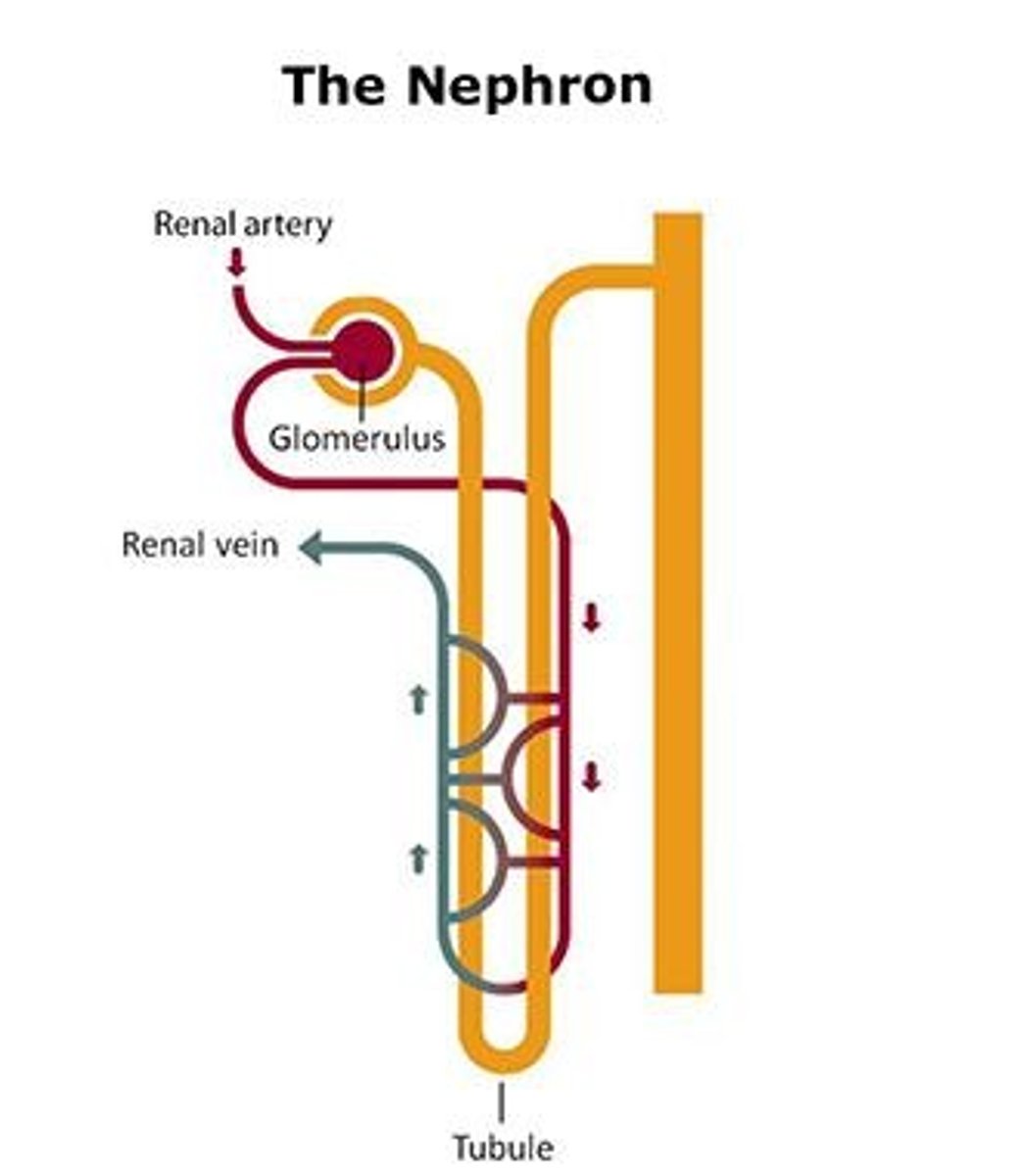
What is the difference between osmoregulators and osmoconformers?
Osmoregulators actively maintain internal solute concentrations, while osmoconformers allow their internal concentrations to fluctuate with the environment.
What adaptations do insects have to prevent water loss?
A waxy cuticle on their exoskeleton.
What is the consequence of prolonged osmotic stress?
It can disrupt homeostasis and be fatal.
How do terrestrial mammals reabsorb water from urine?
By reducing the kidney filtration rate.
What is metabolic water and how is it utilized?
Water produced during cellular respiration, used by organisms to replace lost water.
What percentage of dehydration can camels withstand compared to humans?
Camels can withstand 10% more dehydration than humans.
How much longer can animals withstand dehydration compared to humans?
10% more than humans.
How long can certain animals go without water?
Up to 2 months.
What is the primary hormone involved in the hormonal control of water balance in mammals?
Antidiuretic hormone (ADH).
Where is the majority of water reabsorbed in mammals?
In the loop of Henle and the collecting duct of the nephron.
How do mammals in dry regions differ from those in water-rich environments regarding the loop of Henle?
Mammals in dry regions have a longer loop of Henle.
What happens to ADH levels when water levels in the blood are low?
More ADH is released, increasing water retention.
What happens to ADH levels when water levels in the blood are high?
Less ADH is released, resulting in dilute urine.
What are the three main functions of each nephron?
1. Filter the blood 2. Reabsorb required molecules and water 3. Secrete unwanted waste materials.
What is the composition of filtrate collected in Bowman's capsule?
Water, ions, glucose, amino acids, and urea.
What is the role of the proximal convoluted tubule in osmoregulation?
It reabsorbs molecules like glucose and amino acids via active and passive transport.
What ions are reabsorbed by the distal convoluted tubule?
Sodium, potassium, and calcium.
What is the role of the Loop of Henle in water reabsorption?
It reabsorbs water by osmosis and collects sodium chloride.
How does ADH affect the permeability of the collecting duct walls?
It increases permeability, allowing more water reuptake from the filtrate.
What structural adaptation do plants have to reduce evaporation?
A cuticle, which is a waxy layer.
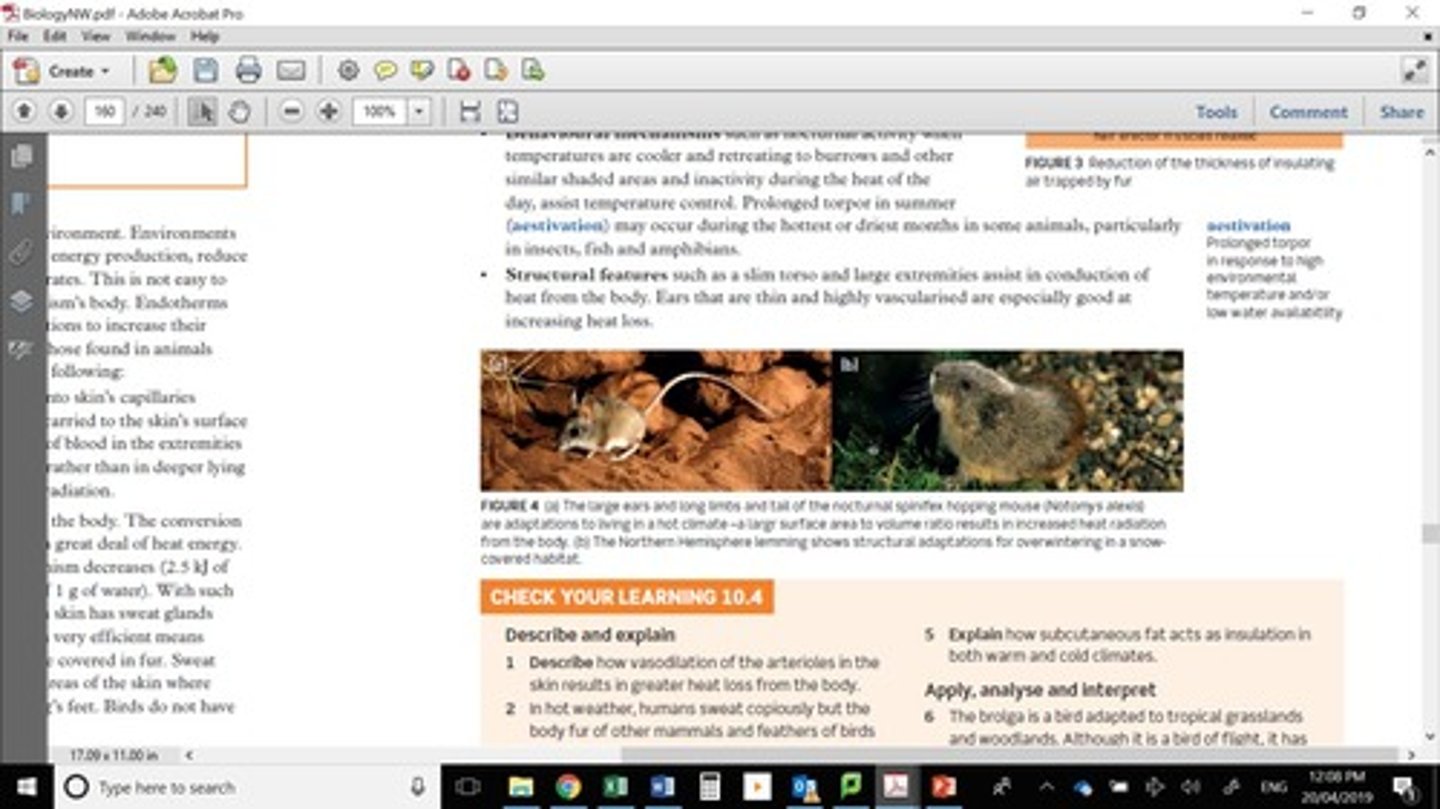
What role do stomata and guard cells play in plants?
They control water loss by opening and closing based on water availability.
What is the function of vacuoles in plant cells regarding water?
They store water and maintain turgor pressure, influencing stomatal function.
What is abscisic acid (ABA) and its role in plants?
A stress hormone that signals stomatal closure during drought conditions.
What is the significance of adaptations for osmoregulation in animals?
They enable survival in environments with varying water availability.
What is the primary focus of the video 'How do animals survive in the desert'?
It discusses adaptations for osmoregulation in desert animals.
What is the purpose of the 'Crash Course Excretory System'?
It provides an overview of the excretory system and water balance.
What is the importance of the collecting duct in the nephron?
It plays a crucial role in the reabsorption of water and concentration of urine.
What are the common traits of Thermoregulators and Thermoconformers?
Thermoregulators maintain a constant internal temperature independent of the environment, while Thermoconformers adopt the surrounding environmental temperature.
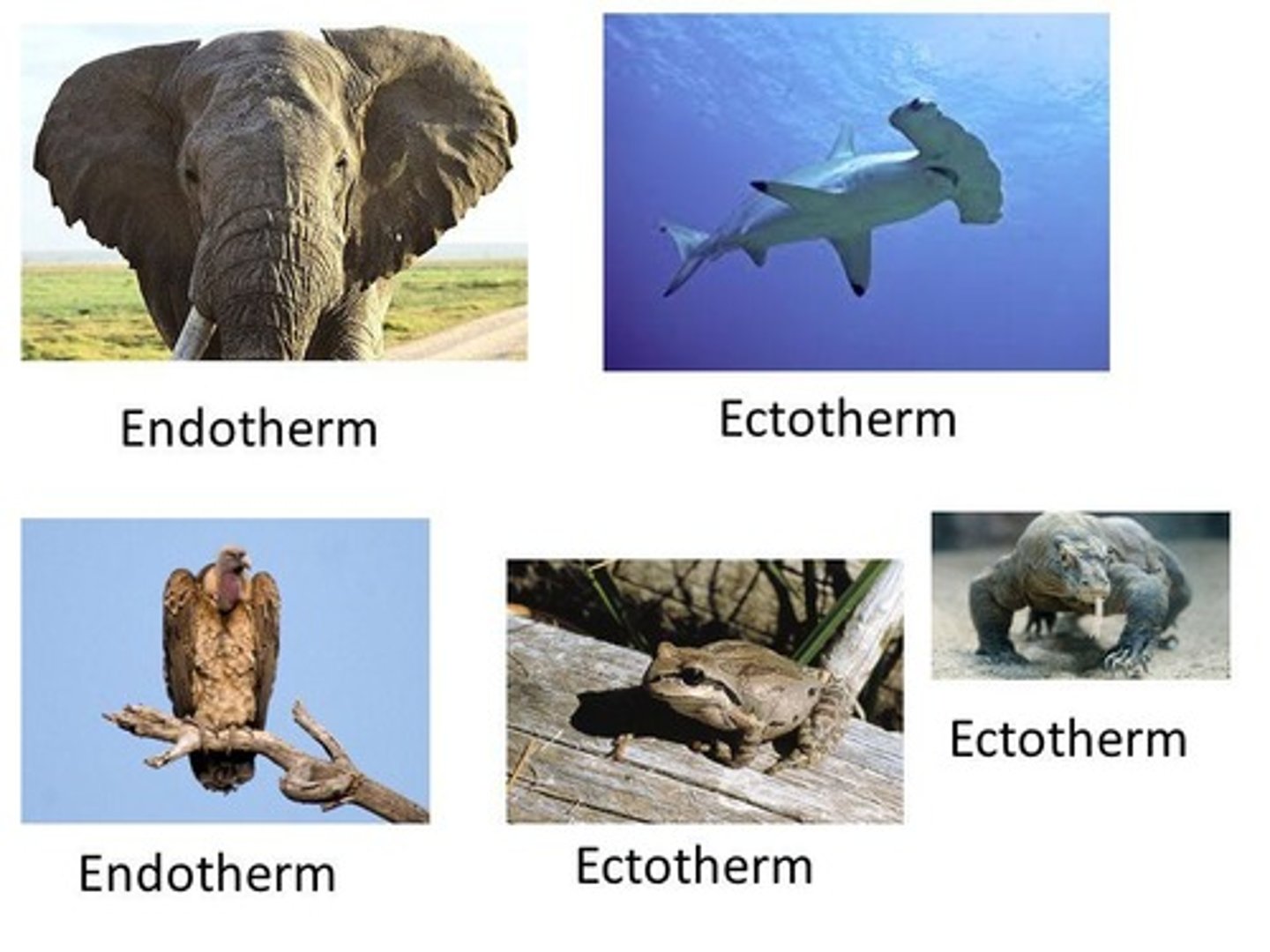
How do organisms gain heat?
Organisms can gain heat through metabolism and/or through direct or indirect absorption of solar energy.
What are the methods of heat exchange with the environment?
Heat exchanges occur via conduction, radiation, and evaporation.
What is the difference between Ectotherms and Endotherms?
Ectotherms control body temperature by gaining heat from the environment, while Endotherms generate heat internally through metabolic activity.
What is a Homoeothermic organism?
A Homoeothermic organism maintains a relatively constant body temperature independent from the surrounding environment.
What are the three types of adaptations for thermoregulation?
The three types of adaptations are structural, behavioral, and physiological.
Give an example of a structural adaptation for cold climates.
Short ears in cold environments to reduce heat loss.
What is a behavioral adaptation for thermoregulation?
Congregating close together to share body heat.
What is a physiological adaptation for thermoregulation?
Regulating blood flow in outer body areas to maintain a constant internal environment.
How does the hypothalamus regulate body temperature?
The hypothalamus acts as a thermostat, receiving information from temperature receptors and triggering responses to maintain body temperature.
What happens when the body is too cold for too long?
Cold centres in the hypothalamus stimulate the release of thyroid stimulating hormone, leading to increased metabolic rate and heat production.
What is the effect of surface area to volume ratio on thermoregulation?
Smaller animals lose heat faster than larger animals due to a higher surface area to volume ratio.
What is the significance of blubber in marine animals?
Blubber reduces heat loss and serves as a long-term food source.
How do Ectotherms maintain their body temperature?
Ectotherms change behavior, such as moving into the sun to warm up or into the shade to cool down.
What is the role of metabolic activity in Endotherms?
Higher metabolic activity generates more internal heat, raising the core temperature of the animal.
What is the tolerance range for a species?
The optimal range of abiotic factors in the environment where a species can best survive.
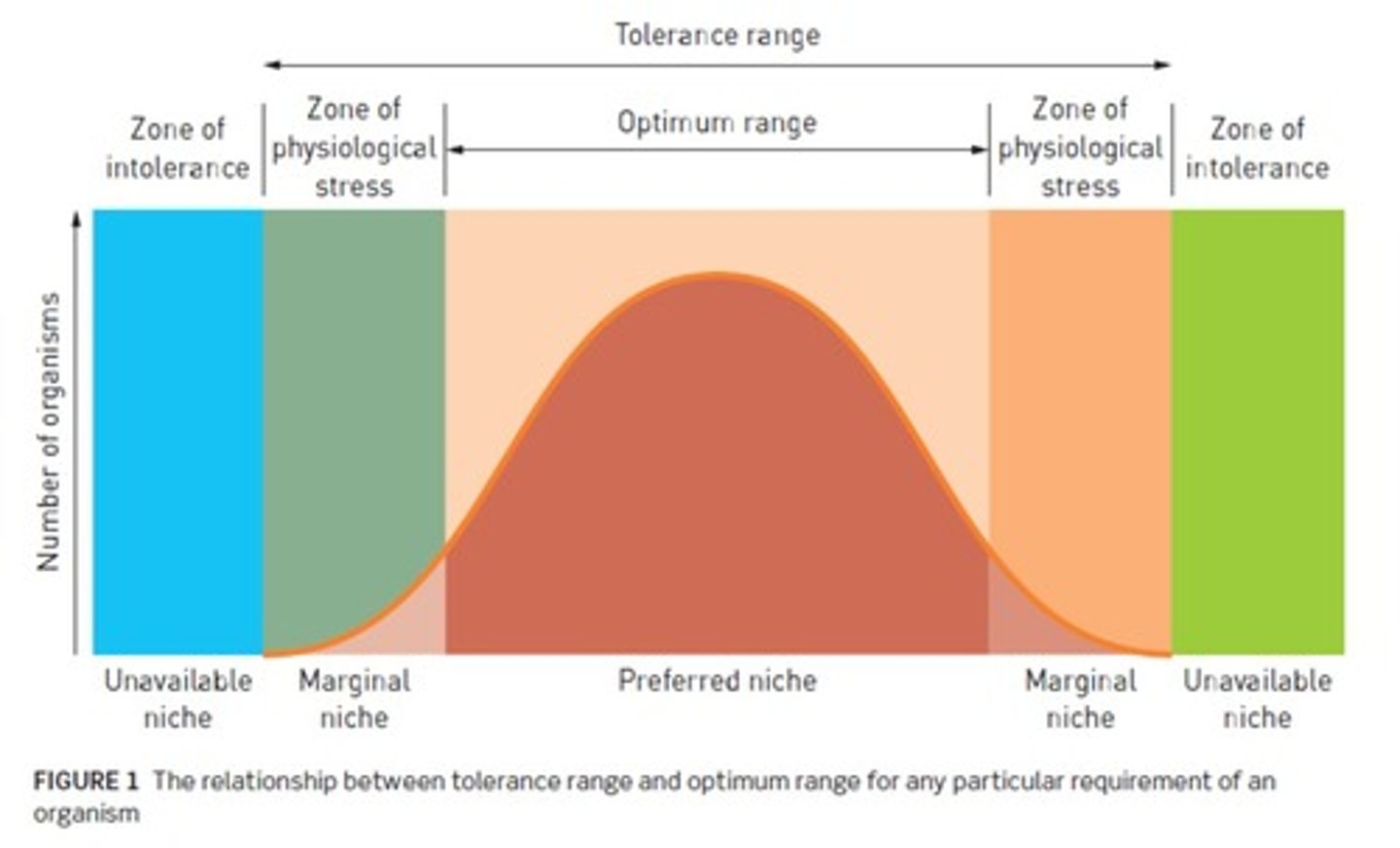
What is the relationship between metabolic rates and animal activity levels?
The more active the animal, the higher its core temperature due to increased ATP needs in muscles.
What adaptations do active animals in cold habitats have?
They typically have a large torso and short extremities to reduce surface area to volume ratio.
What is the importance of the thyroid gland in thermoregulation?
The thyroid gland releases thyroxine hormone, which increases metabolic rate and heat production.
How do adaptations help Endotherms acclimatize to temperature changes?
Adaptations allow Endotherms to adjust their physiological processes to cope with hot or cold weather.
What is the primary advantage of being a Thermoregulator?
Thermoregulators can maintain a wider tolerance range of environmental temperatures.
What is the impact of temperature receptors on thermoregulation?
Temperature receptors send information to the hypothalamus to initiate appropriate thermoregulatory responses.
What is the significance of maintaining a constant internal temperature?
It allows organisms to function optimally despite varying external temperatures.
What adaptations help animals lose heat in hot environments?
Animals in hot climates have a slim torso, large extremities, thin and vascularised ears, and reduced insulation from fur or fat to increase heat loss.
How does a camel's fat reserve contribute to its adaptation in hot climates?
Camels have localized fat reserves, such as a hump, which insulates only one part of the body, helping to manage heat.
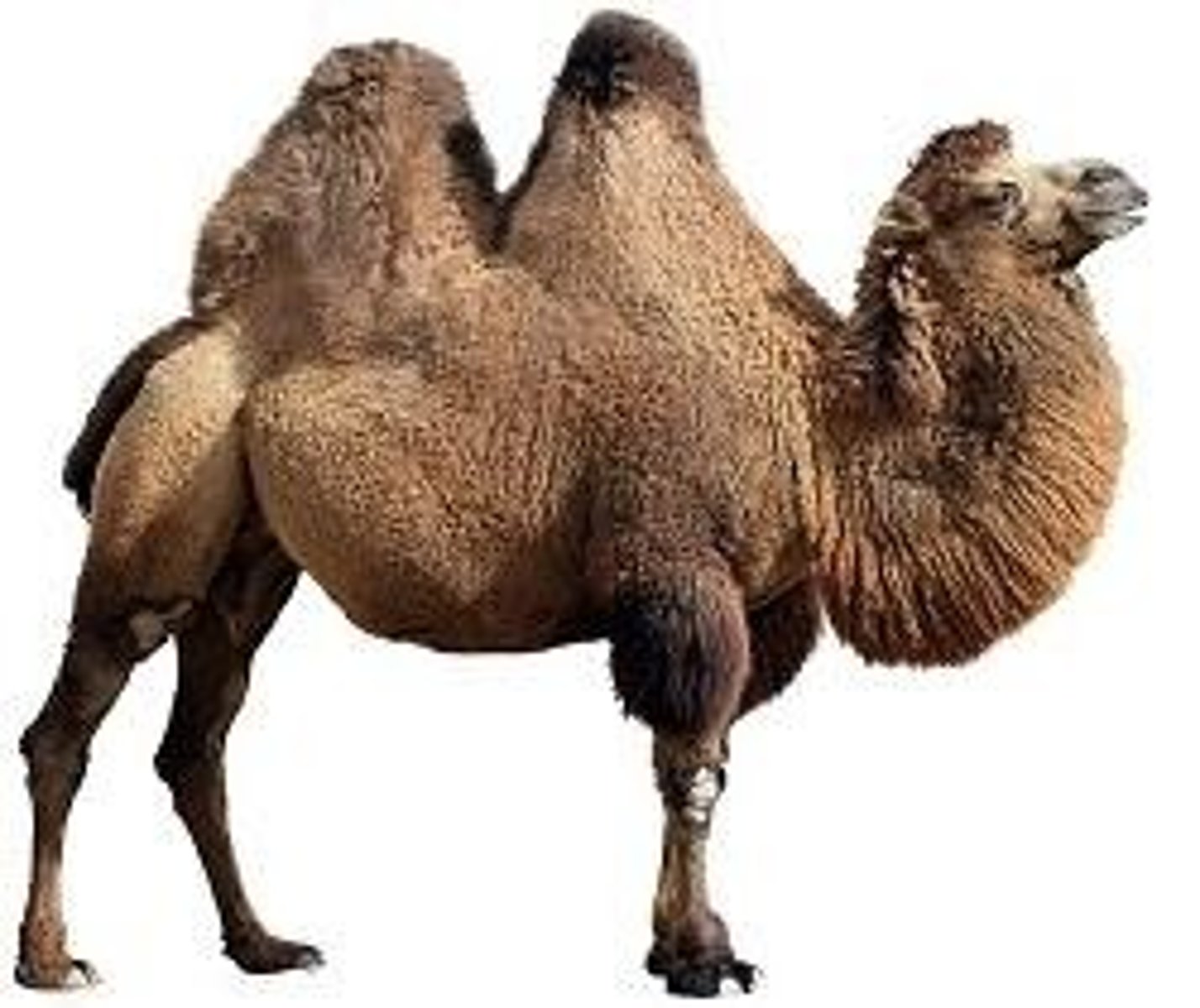
What is the role of hair in animals living in hot climates?
Hair is located on top of the animal to protect from the sun while allowing cooling from below.
What behavioral adaptations do animals exhibit in cold climates to reduce heat loss?
Animals may engage in diurnal activity, huddle in groups (kleptothermy), delay reproduction, and enter torpor or hibernation.
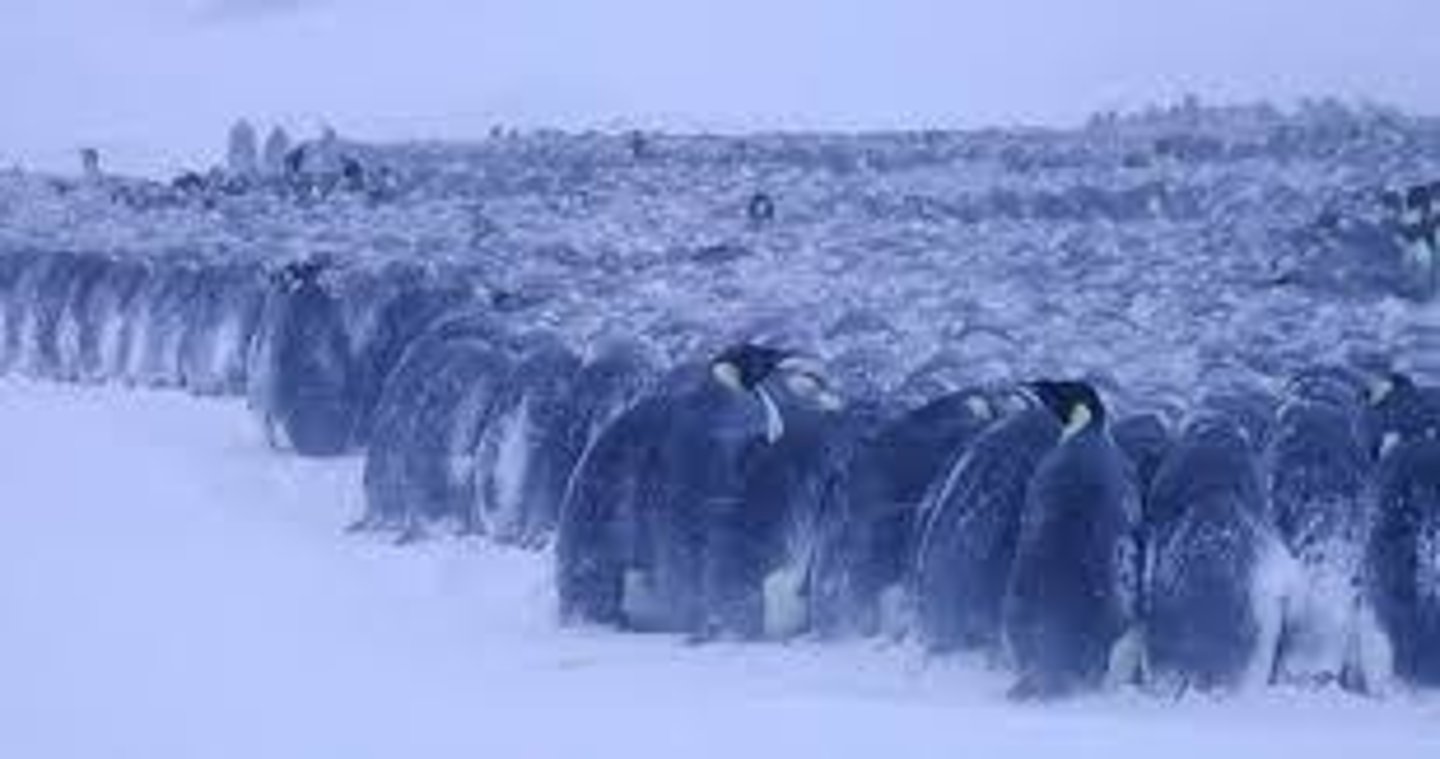
What is torpor, and how does it differ from hibernation?
Torpor is a short-term state of decreased physiological activity, while hibernation is a long-term torpor lasting about six months.
What physiological mechanisms do animals use to reduce heat loss in cold climates?
Physiological mechanisms include vasoconstriction of blood vessels, redirecting blood flow, and employing counter-current heat exchange systems.
How do specialized shunt vessels in extremities help cold habitat animals?
They allow blood to bypass skin capillaries, reducing heat loss in very cold habitats.
What is thermogenesis?
Thermogenesis is the process of heat production in organisms, which can be increased through muscle contraction or hormonal action.
What role does brown adipose tissue play in heat production?
Brown adipose tissue generates heat by metabolizing lipids and contains many mitochondria, releasing most energy as heat.
How do animals cool down in hot climates?
Cooling mechanisms include vasodilation, sweating, panting, and nocturnal activities.
What is the significance of sweating in thermoregulation?
Sweating cools the body as the conversion of sweat from liquid to gas requires energy, facilitating heat loss.
Why are birds unable to sweat?
Birds do not have sweat glands, which limits their ability to cool down through sweating.
How do desert animals like camels manage their core temperature?
Desert animals can allow their core temperature to fluctuate, rising a few degrees during the day to decrease the temperature gradient.
What is the effect of high humidity on sweating?
High humidity makes it difficult for sweat to evaporate, reducing the effectiveness of sweating as a cooling mechanism.
What is aestivation?
Aestivation is a form of hibernation or torpor that occurs during warmer months, often in response to food scarcity.
How does huddling in groups help animals in cold climates?
Huddling allows animals to share body heat, reducing overall heat loss.
What are the effects of vasodilation in hot climates?
Vasodilation increases blood flow to extremities, facilitating heat loss.
What happens to the metabolic rate during hibernation?
During hibernation, the metabolic rate decreases significantly, conserving energy.
How does the body manage blood flow during cold conditions?
Blood flow is redirected to major organs, away from extremities, to conserve heat.
What is the relationship between muscle contraction and heat production?
Increased muscle contraction, such as shivering, raises the metabolic rate and generates heat.
How does the arrangement of blood vessels in cold habitat animals help with heat conservation?
Arteries and veins are arranged closely to transfer heat from warm arterial blood to cooler venous blood, minimizing heat loss.
What is the primary function of brown fat in cold conditions?
Brown fat is specialized for rapid heat production and requires higher food intake to maintain activity.
What is kleptothermy?
Kleptothermy is the behavioral strategy of sharing body heat by huddling together.